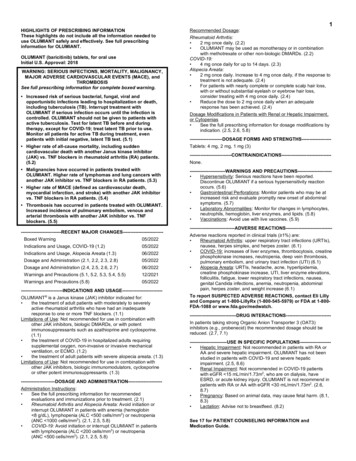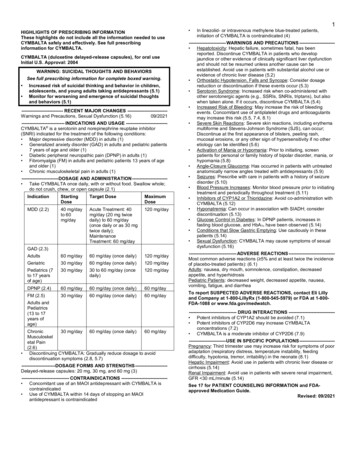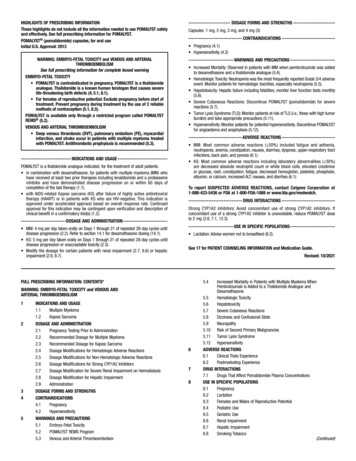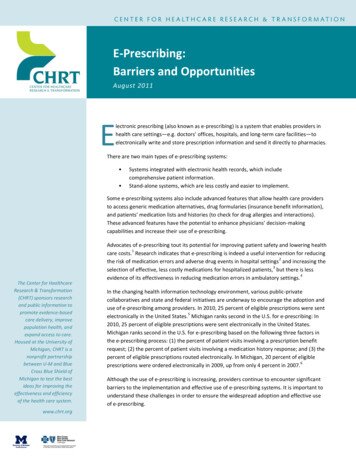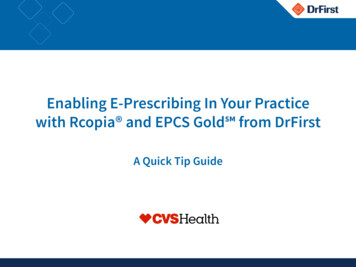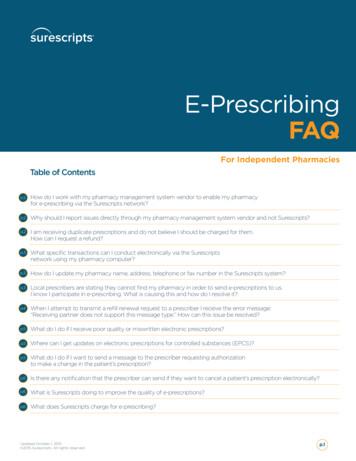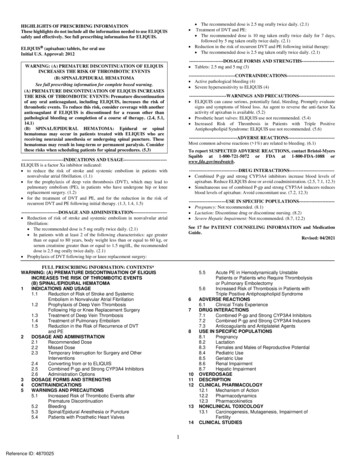
Transcription
The recommended dose is 2.5 mg orally twice daily. (2.1)Treatment of DVT and PE: The recommended dose is 10 mg taken orally twice daily for 7 days,followed by 5 mg taken orally twice daily. (2.1) Reduction in the risk of recurrent DVT and PE following initial therapy: The recommended dose is 2.5 mg taken orally twice daily. (2.1)HIGHLIGHTS OF PRESCRIBING INFORMATIONThese highlights do not include all the information needed to use ELIQUISsafely and effectively. See full prescribing information for ELIQUIS. ELIQUIS (apixaban) tablets, for oral useInitial U.S. Approval: 2012----------------------DOSAGE FORMS AND STRENGTHS-------------------- Tablets: 2.5 mg and 5 mg (3)WARNING: (A) PREMATURE DISCONTINUATION OF ELIQUISINCREASES THE RISK OF THROMBOTIC EVENTS(B) SPINAL/EPIDURAL HEMATOMASee full prescribing information for complete boxed warning.(A) PREMATURE DISCONTINUATION OF ELIQUIS INCREASESTHE RISK OF THROMBOTIC EVENTS: Premature discontinuationof any oral anticoagulant, including ELIQUIS, increases the risk ofthrombotic events. To reduce this risk, consider coverage with anotheranticoagulant if ELIQUIS is discontinued for a reason other thanpathological bleeding or completion of a course of therapy. (2.4, 5.1,14.1)(B) SPINAL/EPIDURAL HEMATOMA: Epidural or spinalhematomas may occur in patients treated with ELIQUIS who arereceiving neuraxial anesthesia or undergoing spinal puncture. Thesehematomas may result in long-term or permanent paralysis. Considerthese risks when scheduling patients for spinal procedures. NS------------------------------ Active pathological bleeding (4) Severe hypersensitivity to ELIQUIS (4)------------------------WARNINGS AND PRECAUTIONS---------------------- ELIQUIS can cause serious, potentially fatal, bleeding. Promptly evaluatesigns and symptoms of blood loss. An agent to reverse the anti-factor Xaactivity of apixaban is available. (5.2) Prosthetic heart valves: ELIQUIS use not recommended. (5.4) Increased Risk of Thrombosis in Patients with Triple PositiveAntiphospholipid Syndrome: ELIQUIS use not recommended. (5.6)-------------------------------ADVERSE REACTIONS----------------------------- Most common adverse reactions ( 1%) are related to bleeding. (6.1)To report SUSPECTED ADVERSE REACTIONS, contact Bristol-MyersSquibb at 1-800-721-5072 or FDA at 1-800-FDA-1088 INDICATIONS AND USAGE--------------------------- ELIQUIS is a factor Xa inhibitor indicated: to reduce the risk of stroke and systemic embolism in patients withnonvalvular atrial fibrillation. (1.1) for the prophylaxis of deep vein thrombosis (DVT), which may lead topulmonary embolism (PE), in patients who have undergone hip or kneereplacement surgery. (1.2) for the treatment of DVT and PE, and for the reduction in the risk ofrecurrent DVT and PE following initial therapy. (1.3, 1.4, 1.5)--------------------------------DRUG INTERACTIONS---------------------------- Combined P-gp and strong CYP3A4 inhibitors increase blood levels ofapixaban. Reduce ELIQUIS dose or avoid coadministration. (2.5, 7.1, 12.3) Simultaneous use of combined P-gp and strong CYP3A4 inducers reducesblood levels of apixaban: Avoid concomitant use. (7.2, 12.3)------------------------DOSAGE AND ADMINISTRATION--------------------- Reduction of risk of stroke and systemic embolism in nonvalvular atrialfibrillation: The recommended dose is 5 mg orally twice daily. (2.1) In patients with at least 2 of the following characteristics: age greaterthan or equal to 80 years, body weight less than or equal to 60 kg, orserum creatinine greater than or equal to 1.5 mg/dL, the recommendeddose is 2.5 mg orally twice daily. (2.1) Prophylaxis of DVT following hip or knee replacement surgery:See 17 for PATIENT COUNSELING INFORMATION and MedicationGuide.Revised: 04/2021------------------------USE IN SPECIFIC POPULATIONS---------------------- Pregnancy: Not recommended. (8.1) Lactation: Discontinue drug or discontinue nursing. (8.2) Severe Hepatic Impairment: Not recommended. (8.7, 12.2)FULL PRESCRIBING INFORMATION: CONTENTS*WARNING: (A) PREMATURE DISCONTINUATION OF ELIQUISINCREASES THE RISK OF THROMBOTIC EVENTS(B) SPINAL/EPIDURAL HEMATOMA1INDICATIONS AND USAGE1.1Reduction of Risk of Stroke and SystemicEmbolism in Nonvalvular Atrial Fibrillation1.2Prophylaxis of Deep Vein ThrombosisFollowing Hip or Knee Replacement Surgery1.3Treatment of Deep Vein Thrombosis1.4Treatment of Pulmonary Embolism1.5Reduction in the Risk of Recurrence of DVTand PE2DOSAGE AND ADMINISTRATION2.1Recommended Dose2.2Missed Dose2.3Temporary Interruption for Surgery and OtherInterventions2.4Converting from or to ELIQUIS2.5Combined P-gp and Strong CYP3A4 Inhibitors2.6Administration Options3DOSAGE FORMS AND STRENGTHS4CONTRAINDICATIONS5WARNINGS AND PRECAUTIONS5.1Increased Risk of Thrombotic Events afterPremature Discontinuation5.2Bleeding5.3Spinal/Epidural Anesthesia or Puncture5.4Patients with Prosthetic Heart Valves5.567810111213141Reference ID: 4870025Acute PE in Hemodynamically UnstablePatients or Patients who Require Thrombolysisor Pulmonary Embolectomy5.6Increased Risk of Thrombosis in Patients withTriple Positive Antiphospholipid SyndromeADVERSE REACTIONS6.1Clinical Trials ExperienceDRUG INTERACTIONS7.1Combined P-gp and Strong CYP3A4 Inhibitors7.2Combined P-gp and Strong CYP3A4 Inducers7.3Anticoagulants and Antiplatelet AgentsUSE IN SPECIFIC POPULATIONS8.1Pregnancy8.2Lactation8.3Females and Males of Reproductive Potential8.4Pediatric Use8.5Geriatric Use8.6Renal Impairment8.7Hepatic ImpairmentOVERDOSAGEDESCRIPTIONCLINICAL PHARMACOLOGY12.1Mechanism of LINICAL TOXICOLOGY13.1Carcinogenesis, Mutagenesis, Impairment ofFertilityCLINICAL STUDIES
14.114.214.31617Reduction of Risk of Stroke and SystemicEmbolism in Nonvalvular Atrial FibrillationProphylaxis of Deep Vein ThrombosisFollowing Hip or Knee Replacement SurgeryTreatment of DVT and PE and Reduction in theRisk of Recurrence of DVT and PE* Sections or subsections omitted from the full prescribing informationare not listed.2Reference ID: 4870025HOW SUPPLIED/STORAGE AND HANDLINGPATIENT COUNSELING INFORMATION
FULL PRESCRIBING INFORMATIONWARNING: (A) PREMATURE DISCONTINUATION OF ELIQUIS INCREASES THERISK OF THROMBOTIC EVENTS(B) SPINAL/EPIDURAL HEMATOMA(A) PREMATURE DISCONTINUATION OF ELIQUIS INCREASES THE RISK OFTHROMBOTIC EVENTSPremature discontinuation of any oral anticoagulant, including ELIQUIS, increases the riskof thrombotic events. If anticoagulation with ELIQUIS is discontinued for a reason otherthan pathological bleeding or completion of a course of therapy, consider coverage withanother anticoagulant [see Dosage and Administration (2.4), Warnings and Precautions (5.1),and Clinical Studies (14.1)].(B) SPINAL/EPIDURAL HEMATOMAEpidural or spinal hematomas may occur in patients treated with ELIQUIS who arereceiving neuraxial anesthesia or undergoing spinal puncture. These hematomas may resultin long-term or permanent paralysis. Consider these risks when scheduling patients forspinal procedures. Factors that can increase the risk of developing epidural or spinalhematomas in these patients include: use of indwelling epidural cathetersconcomitant use of other drugs that affect hemostasis, such as nonsteroidal antiinflammatory drugs (NSAIDs), platelet inhibitors, other anticoagulantsa history of traumatic or repeated epidural or spinal puncturesa history of spinal deformity or spinal surgeryoptimal timing between the administration of ELIQUIS and neuraxial procedures is notknown[see Warnings and Precautions (5.3)]Monitor patients frequently for signs and symptoms of neurological impairment. Ifneurological compromise is noted, urgent treatment is necessary [see Warnings andPrecautions (5.3)].Consider the benefits and risks before neuraxial intervention in patients anticoagulated orto be anticoagulated [see Warnings and Precautions (5.3)].1INDICATIONS AND USAGE1.1Reduction of Risk of Stroke and Systemic Embolism in NonvalvularAtrial FibrillationELIQUIS is indicated to reduce the risk of stroke and systemic embolism in patients withnonvalvular atrial fibrillation.3Reference ID: 4870025
1.2Prophylaxis of Deep Vein Thrombosis Following Hip or KneeReplacement SurgeryELIQUIS is indicated for the prophylaxis of deep vein thrombosis (DVT), which may lead topulmonary embolism (PE), in patients who have undergone hip or knee replacement surgery.1.3Treatment of Deep Vein ThrombosisELIQUIS is indicated for the treatment of DVT.1.4Treatment of Pulmonary EmbolismELIQUIS is indicated for the treatment of PE.1.5Reduction in the Risk of Recurrence of DVT and PEELIQUIS is indicated to reduce the risk of recurrent DVT and PE following initial therapy.2DOSAGE AND ADMINISTRATION2.1Recommended DoseReduction of Risk of Stroke and Systemic Embolism in Patients with Nonvalvular AtrialFibrillationThe recommended dose of ELIQUIS for most patients is 5 mg taken orally twice daily.The recommended dose of ELIQUIS is 2.5 mg twice daily in patients with at least two of thefollowing characteristics: age greater than or equal to 80 yearsbody weight less than or equal to 60 kgserum creatinine greater than or equal to 1.5 mg/dLProphylaxis of Deep Vein Thrombosis Following Hip or Knee Replacement SurgeryThe recommended dose of ELIQUIS is 2.5 mg taken orally twice daily. The initial dose should betaken 12 to 24 hours after surgery. In patients undergoing hip replacement surgery, the recommended duration of treatment is 35days.In patients undergoing knee replacement surgery, the recommended duration of treatment is12 days.Treatment of DVT and PEThe recommended dose of ELIQUIS is 10 mg taken orally twice daily for the first 7 days oftherapy. After 7 days, the recommended dose is 5 mg taken orally twice daily.Reduction in the Risk of Recurrence of DVT and PEThe recommended dose of ELIQUIS is 2.5 mg taken orally twice daily after at least 6 months oftreatment for DVT or PE [see Clinical Studies (14.3)].4Reference ID: 4870025
2.2Missed DoseIf a dose of ELIQUIS is not taken at the scheduled time, the dose should be taken as soon aspossible on the same day and twice-daily administration should be resumed. The dose should notbe doubled to make up for a missed dose.2.3Temporary Interruption for Surgery and Other InterventionsELIQUIS should be discontinued at least 48 hours prior to elective surgery or invasive procedureswith a moderate or high risk of unacceptable or clinically significant bleeding [see Warnings andPrecautions (5.2)]. ELIQUIS should be discontinued at least 24 hours prior to elective surgery orinvasive procedures with a low risk of bleeding or where the bleeding would be non-critical inlocation and easily controlled. Bridging anticoagulation during the 24 to 48 hours after stoppingELIQUIS and prior to the intervention is not generally required. ELIQUIS should be restarted afterthe surgical or other procedures as soon as adequate hemostasis has been established.2.4Converting from or to ELIQUISSwitching from warfarin to ELIQUIS: Warfarin should be discontinued and ELIQUIS started whenthe international normalized ratio (INR) is below 2.0.Switching from ELIQUIS to warfarin: ELIQUIS affects INR, so that initial INR measurementsduring the transition to warfarin may not be useful for determining the appropriate dose ofwarfarin. One approach is to discontinue ELIQUIS and begin both a parenteral anticoagulant andwarfarin at the time the next dose of ELIQUIS would have been taken, discontinuing the parenteralanticoagulant when INR reaches an acceptable range.Switching from ELIQUIS to anticoagulants other than warfarin (oral or parenteral): DiscontinueELIQUIS and begin taking the new anticoagulant other than warfarin at the usual time of the nextdose of ELIQUIS.Switching from anticoagulants other than warfarin (oral or parenteral) to ELIQUIS: Discontinuethe anticoagulant other than warfarin and begin taking ELIQUIS at the usual time of the next doseof the anticoagulant other than warfarin.2.5Combined P-gp and Strong CYP3A4 InhibitorsFor patients receiving ELIQUIS doses of 5 mg or 10 mg twice daily, reduce the dose by 50% whenELIQUIS is coadministered with drugs that are combined P-glycoprotein (P-gp) and strongcytochrome P450 3A4 (CYP3A4) inhibitors (e.g., ketoconazole, itraconazole, ritonavir) [seeClinical Pharmacology (12.3)].In patients already taking 2.5 mg twice daily, avoid coadministration of ELIQUIS with combinedP-gp and strong CYP3A4 inhibitors [see Drug Interactions (7.1)].2.6Administration OptionsFor patients who are unable to swallow whole tablets, 5 mg and 2.5 mg ELIQUIS tablets may becrushed and suspended in water, 5% dextrose in water (D5W), or apple juice, or mixed withapplesauce and promptly administered orally [see Clinical Pharmacology (12.3)]. Alternatively,5Reference ID: 4870025
ELIQUIS tablets may be crushed and suspended in 60 mL of water or D5W and promptly deliveredthrough a nasogastric tube [see Clinical Pharmacology (12.3)].Crushed ELIQUIS tablets are stable in water, D5W, apple juice, and applesauce for up to 4 hours.3DOSAGE FORMS AND STRENGTHS 2.5 mg, yellow, round, biconvex, film-coated tablets with “893” debossed on one side and“2½” on the other side. 5 mg, pink, oval-shaped, biconvex, film-coated tablets with “894” debossed on one side and“5” on the other side.4CONTRAINDICATIONSELIQUIS is contraindicated in patients with the following conditions: Active pathological bleeding [see Warnings and Precautions (5.2) and Adverse Reactions(6.1)]Severe hypersensitivity reaction to ELIQUIS (e.g., anaphylactic reactions) [see AdverseReactions (6.1)]5WARNINGS AND PRECAUTIONS5.1Increased Risk of Thrombotic Events after Premature DiscontinuationPremature discontinuation of any oral anticoagulant, including ELIQUIS, in the absence ofadequate alternative anticoagulation increases the risk of thrombotic events. An increased rate ofstroke was observed during the transition from ELIQUIS to warfarin in clinical trials in atrialfibrillation patients. If ELIQUIS is discontinued for a reason other than pathological bleeding orcompletion of a course of therapy, consider coverage with another anticoagulant [see Dosage andAdministration (2.4) and Clinical Studies (14.1)].5.2BleedingELIQUIS increases the risk of bleeding and can cause serious, potentially fatal, bleeding [seeDosage and Administration (2.1) and Adverse Reactions (6.1)].Concomitant use of drugs affecting hemostasis increases the risk of bleeding. These include aspirinand other antiplatelet agents, other anticoagulants, heparin, thrombolytic agents, selectiveserotonin reuptake inhibitors, serotonin norepinephrine reuptake inhibitors, and nonsteroidal antiinflammatory drugs (NSAIDs) [see Drug Interactions (7.3)].Advise patients of signs and symptoms of blood loss and to report them immediately or go to anemergency room. Discontinue ELIQUIS in patients with active pathological hemorrhage.Reversal of Anticoagulant EffectAn agent to reverse the anti-factor Xa activity of apixaban is available. The pharmacodynamiceffect of ELIQUIS can be expected to persist for at least 24 hours after the last dose, i.e., for abouttwo drug half-lives. Prothrombin complex concentrate (PCC), activated prothrombin complexconcentrate or recombinant factor VIIa may be considered, but have not been evaluated in clinical6Reference ID: 4870025
studies [see Clinical Pharmacology (12.2)]. When PCCs are used, monitoring for theanticoagulation effect of apixaban using a clotting test (PT, INR, or aPTT) or anti-factor Xa (FXa)activity is not useful and is not recommended. Activated oral charcoal reduces absorption ofapixaban, thereby lowering apixaban plasma concentration [see Overdosage (10)].Hemodialysis does not appear to have a substantial impact on apixaban exposure [see ClinicalPharmacology (12.3)]. Protamine sulfate and vitamin K are not expected to affect theanticoagulant activity of apixaban. There is no experience with antifibrinolytic agents (tranexamicacid, aminocaproic acid) in individuals receiving apixaban. There is no experience with systemichemostatics (desmopressin) in individuals receiving ELIQUIS, and they are not expected to beeffective as a reversal agent.5.3Spinal/Epidural Anesthesia or PunctureWhen neuraxial anesthesia (spinal/epidural anesthesia) or spinal/epidural puncture is employed,patients treated with antithrombotic agents for prevention of thromboembolic complications are atrisk of developing an epidural or spinal hematoma which can result in long-term or permanentparalysis.The risk of these events may be increased by the postoperative use of indwelling epidural cathetersor the concomitant use of medicinal products affecting hemostasis. Indwelling epidural orintrathecal catheters should not be removed earlier than 24 hours after the last administration ofELIQUIS. The next dose of ELIQUIS should not be administered earlier than 5 hours after theremoval of the catheter. The risk may also be increased by traumatic or repeated epidural or spinalpuncture. If traumatic puncture occurs, delay the administration of ELIQUIS for 48 hours.Monitor patients frequently for signs and symptoms of neurological impairment (e.g., numbnessor weakness of the legs, or bowel or bladder dysfunction). If neurological compromise is noted,urgent diagnosis and treatment is necessary. Prior to neuraxial intervention the physician shouldconsider the potential benefit versus the risk in anticoagulated patients or in patients to beanticoagulated for thromboprophylaxis.5.4Patients with Prosthetic Heart ValvesThe safety and efficacy of ELIQUIS have not been studied in patients with prosthetic heart valves.Therefore, use of ELIQUIS is not recommended in these patients.5.5Acute PE in Hemodynamically Unstable Patients or Patients whoRequire Thrombolysis or Pulmonary EmbolectomyInitiation of ELIQUIS is not recommended as an alternative to unfractionated heparin for the initialtreatment of patients with PE who present with hemodynamic instability or who may receivethrombolysis or pulmonary embolectomy.5.6Increased Risk of Thrombosis in Patients with Triple PositiveAntiphospholipid SyndromeDirect-acting oral anticoagulants (DOACs), including ELIQUIS, are not recommended for use inpatients with triple-positive antiphospholipid syndrome (APS). For patients with APS (especially7Reference ID: 4870025
those who are triple positive [positive for lupus anticoagulant, anticardiolipin, and anti–beta 2 glycoprotein I antibodies]), treatment with DOACs has been associated with increased rates ofrecurrent thrombotic events compared with vitamin K antagonist therapy.6ADVERSE REACTIONSThe following clinically significant adverse reactions are discussed in greater detail in othersections of the prescribing information. Increased Risk of Thrombotic Events After Premature Discontinuation [see Warnings andPrecautions (5.1)]Bleeding [see Warnings and Precautions (5.2)]Spinal/Epidural Anesthesia or Puncture [see Warnings and Precautions (5.3)]6.1Clinical Trials ExperienceBecause clinical trials are conducted under widely varying conditions, adverse reaction ratesobserved in the clinical trials of a drug cannot be directly compared to rates in the clinical trials ofanother drug and may not reflect the rates observed in practice.Reduction of Risk of Stroke and Systemic Embolism in Patients with Nonvalvular AtrialFibrillationThe safety of ELIQUIS was evaluated in the ARISTOTLE and AVERROES studies [see ClinicalStudies (14)], including 11,284 patients exposed to ELIQUIS 5 mg twice daily and 602 patientsexposed to ELIQUIS 2.5 mg twice daily. The duration of ELIQUIS exposure was 12 months for9375 patients and 24 months for 3369 patients in the two studies. In ARISTOTLE, the meanduration of exposure was 89 weeks ( 15,000 patient-years). In AVERROES, the mean durationof exposure was approximately 59 weeks ( 3000 patient-years).The most common reason for treatment discontinuation in both studies was for bleeding-relatedadverse reactions; in ARISTOTLE this occurred in 1.7% and 2.5% of patients treated withELIQUIS and warfarin, respectively, and in AVERROES, in 1.5% and 1.3% on ELIQUIS andaspirin, respectively.Bleeding in Patients with Nonvalvular Atrial Fibrillation in ARISTOTLE and AVERROESTables 1 and 2 show the number of patients experiencing major bleeding during the treatmentperiod and the bleeding rate (percentage of subjects with at least one bleeding event per 100patient-years) in ARISTOTLE and AVERROES.8Reference ID: 4870025
Table 1:Bleeding Events in Patients with Nonvalvular Atrial Fibrillation inARISTOTLE*Major†Intracranial (ICH)‡Hemorrhagic stroke§Other ICHGastrointestinal (GI)Fatal**IntracranialNon-intracranial¶ELIQUISN 9088n (per 100 pt-year)327 (2.13)WarfarinN 9052n (per 100 pt-year)462 (3.09)Hazard Ratio(95% CI)P-value0.69 (0.60, 0.80) 0.000152 (0.33)125 (0.82)0.41 (0.30, 0.57) 38 (0.24)74 (0.49)0.51 (0.34, 0.75) 15 (0.10)128 (0.83)51 (0.34)141 (0.93)0.29 (0.16, 0.51)0.89 (0.70, 1.14) 10 (0.06)4 (0.03)6 (0.04)37 (0.24)30 (0.20)7 (0.05)0.27 (0.13, 0.53)0.13 (0.05, 0.37)0.84 (0.28, 2.15) * Bleeding events within each subcategory were counted once per subject, but subjects may have contributed eventsto multiple endpoints. Bleeding events were counted during treatment or within 2 days of stopping study treatment(on-treatment period).†Defined as clinically overt bleeding accompanied by one or more of the following: a decrease in hemoglobin of 2g/dL, a transfusion of 2 or more units of packed red blood cells, bleeding at a critical site: intracranial, intraspinal,intraocular, pericardial, intra-articular, intramuscular with compartment syndrome, retroperitoneal or with fataloutcome.‡Intracranial bleed includes intracerebral, intraventricular, subdural, and subarachnoid bleeding. Any type ofhemorrhagic stroke was adjudicated and counted as an intracranial major bleed.§On-treatment analysis based on the safety population, compared to ITT analysis presented in Section 14.¶GI bleed includes upper GI, lower GI, and rectal bleeding.**Fatal bleeding is an adjudicated death with the primary cause of death as intracranial bleeding or non-intracranialbleeding during the on-treatment period.In ARISTOTLE, the results for major bleeding were generally consistent across most majorsubgroups including age, weight, CHADS2 score (a scale from 0 to 6 used to estimate risk ofstroke, with higher scores predicting greater risk), prior warfarin use, geographic region, andaspirin use at randomization (Figure 1). Subjects treated with ELIQUIS with diabetes bled more(3% per year) than did subjects without diabetes (1.9% per year).9Reference ID: 4870025
Figure 1:Major Bleeding Hazard Ratios by Baseline Characteristics –ARISTOTLE StudyNote: The figure above presents effects in various subgroups, all of which are baseline characteristics and all of whichwere prespecified, if not the groupings. The 95% confidence limits that are shown do not take into account how manycomparisons were made, nor do they reflect the effect of a particular factor after adjustment for all other factors.Apparent homogeneity or heterogeneity among groups should not be over-interpreted.10Reference ID: 4870025
Table 2:Bleeding Events in Patients with Nonvalvular Atrial Fibrillation inAVERROESELIQUISN 2798n (%/year)AspirinN 2780n (%/year)Hazard Ratio(95% CI)P-value45 (1.41)5 (0.16)11 (0.34)29 (0.92)5 (0.16)11 (0.35)1.54 (0.96, 2.45)0.99 (0.23, 4.29)0.99 (0.39, 2.51)0.07 MajorFatalIntracranialEvents associated with each endpoint were counted once per subject, but subjects may have contributed events tomultiple endpoints.Other Adverse ReactionsHypersensitivity reactions (including drug hypersensitivity, such as skin rash, and anaphylacticreactions, such as allergic edema) and syncope were reported in 1% of patients receivingELIQUIS.Prophylaxis of Deep Vein Thrombosis Following Hip or Knee Replacement SurgeryThe safety of ELIQUIS has been evaluated in 1 Phase II and 3 Phase III studies including 5924patients exposed to ELIQUIS 2.5 mg twice daily undergoing major orthopedic surgery of the lowerlimbs (elective hip replacement or elective knee replacement) treated for up to 38 days.In total, 11% of the patients treated with ELIQUIS 2.5 mg twice daily experienced adversereactions.Bleeding results during the treatment period in the Phase III studies are shown in Table 3. Bleedingwas assessed in each study beginning with the first dose of double-blind study drug.11Reference ID: 4870025
Table 3:BleedingEndpoint*All treatedMajor(includingsurgical site)Bleeding During the Treatment Period in Patients UndergoingElective Hip or Knee Replacement SurgeryADVANCE-3Hip Replacement SurgeryADVANCE-2Knee Replacement SurgeryADVANCE-1Knee Replacement SurgeryELIQUIS2.5 mg po bid35 3 daysEnoxaparin40 mg sc qd35 3 daysELIQUIS2.5 mg po bid12 2 daysEnoxaparin40 mg sc qd12 2 daysELIQUIS2.5 mg po bid12 2 daysEnoxaparin30 mg scq12h12 2 daysFirst dose12 to 24hours postsurgeryFirst dose9 to 15hours priorto surgeryFirst dose12 to 24hours postsurgeryFirst dose9 to 15hours priorto surgeryFirst dose12 to 24hours postsurgeryFirst dose12 to 24hours postsurgeryN 2673N 2659N 1501N 1508N 1596N 158814 (0.93%)11 (0.69%)22 (1.39%)†‡22 (0.82%)18 (0.68%)9 (0.60%)000001 (0.06%)Hgbdecrease 2 g/dL13 (0.49%)10 (0.38%)8 (0.53%)9 (0.60%)10 (0.63%)16 (1.01%)Transfusionof 2 unitsRBC16 (0.60%)14 (0.53%)5 (0.33%)9 (0.60%)9 (0.56%)18 (1.13%)Bleed atcritical site§1 (0.04%)1 (0.04%)1 (0.07%)2 (0.13%)1 (0.06%)4 (0.25%)Major CRNM¶129 (4.83%)134 (5.04%)53 (3.53%)72 (4.77%)46 (2.88%)68 (4.28%)All313 (11.71%)334 (12.56%)104 (6.93%)126 (8.36%)85 (5.33%)108 (6.80%)Fatal* All bleeding criteria included surgical site bleeding.†Includes 13 subjects with major bleeding events that occurred before the first dose of ELIQUIS (administered 12to 24 hours post-surgery).‡Includes 5 subjects with major bleeding events that occurred before the first dose of ELIQUIS (administered 12 to24 hours post-surgery).§Intracranial, intraspinal, intraocular, pericardial, an operated joint requiring re-operation or intervention,intramuscular with compartment syndrome, or retroperitoneal. Bleeding into an operated joint requiring reoperation or intervention was present in all patients with this category of bleeding. Events and event rates includeone enoxaparin-treated patient in ADVANCE-1 who also had intracranial hemorrhage.¶CRNM clinically relevant nonmajor.Adverse reactions occurring in 1% of patients undergoing hip or knee replacement surgery in the1 Phase II study and the 3 Phase III studies are listed in Table 4.12Reference ID: 4870025
Table 4:Adverse Reactions Occurring in 1% of Patients in Either GroupUndergoing Hip or Knee Replacement SurgeryELIQUIS, n (%)2.5 mg po bidN 5924Enoxaparin, n (%)40 mg sc qd or30 mg sc q12hN 5904Nausea153 (2.6)159 (2.7)Anemia (including postoperative and hemorrhagic anemia,and respective laboratory parameters)153 (2.6)178 (3.0)Contusion83 (1.4)115 (1.9)Hemorrhage (including hematoma, and vaginal and urethralhemorrhage)67 (1.1)81 (1.4)Postprocedural hemorrhage (including postproceduralhematoma, wound hemorrhage, vessel puncture-sitehematoma, and catheter-site hemorrhage)54 (0.9)60 (1.0)Transaminases increased (including alanine aminotransferaseincreased and alanine aminotransferase abnormal)50 (0.8)71 (1.2)Aspartate aminotransferase increased47 (0.8)69 (1.2)Gamma-glutamyltransferase increased38 (0.6)65 (1.1)Less common adverse reactions in ELIQUIS-treated patients undergoing hip or knee replacementsurgery occurring at a frequency of 0.1% to 1%:Blood and lymphatic system disorders: thrombocytopenia (including platelet count decreases)Vascular disorders: hypotension (including procedural hypotension)Respiratory, thoracic, and mediastinal disorders: epistaxisGastrointestinal disorders: gastrointestinal hemorrhage (including hematemesis and melena),hematocheziaHepatobiliary disorders: liver function test abnormal, blood alkaline phosphatase increased, bloodbilirubin increasedRenal and urinary disorders: hematuria (including respective laboratory parameters)Injury, poisoning, and procedural complications: wound secretion, incision-site hemorrhage(including incision-site hematoma), operative hemorrhageLess common adverse reactions in ELIQUIS-treated patients undergoing hip or knee replacementsurgery occurring at a frequency of 0.1%:Gingival bleeding, hemoptysis, hypersensitivity, muscle hemorrhage, ocular hemorrhage(including conjunctival hemorrhage), rectal hemorrhage13Reference ID: 4870025
Treatment of DVT and PE and Reduction in the Risk of Recurrence of DVT or PEThe safety of ELIQUIS has been evaluated in the AMPLIFY and AMPLIFY-EXT studies,including 2676 patients exposed to ELIQUIS 10 mg twice daily, 3359 patients exposed toELIQUIS 5 mg twice daily, and 840 patients exposed to ELIQUIS 2.5 mg twice daily.Common adverse reactions ( 1%) were gingival bleeding, epistaxis, contusion, hematuria, rectalhemorrhage, hematoma, menorrhagia, and hemoptysis.AMPLIFY StudyThe mean duration of exposure to ELIQUIS was 154 days and to enoxaparin/warfarin was 152days in the AMPLIFY study. Adverse reactions related to bleeding occurred in 417 (15.6%)ELIQUIS-treated patients compared to 661 (24.6%) enoxaparin/warfarin-treated patients. Thediscontinuation rate due to bleeding events was 0.7% in the ELIQUIS-treated patients comparedto 1.7% in enoxaparin/warfarin-treated patients in the AMPLIFY study.In the AMPLIFY study, ELIQUIS was statistically superior to enoxaparin/warfarin in the primarysafety endpoint of major bleeding (relative risk 0.31, 95% CI [0.17, 0.55], P-value 0.0001).Bleeding results from the AMPLIFY study are summarized in Table 5.Table 5:MajorCRNM*Major CRNMMinorAllBleeding Results in the AMPLIFY StudyELIQUISN 2676n (%)Enoxaparin/WarfarinN 2689n (%)Rel
for the prophylaxis of deep vein thrombosis (DVT), which may lead to pulmonary embolism (PE), in patients who have undergone hip or knee replacement surgery. (1.2) for the treatment of DVT and PE, and for the reduction in the risk of recurrent DVT and PE following initial therapy. (1.3, 1.4, 1.5)



